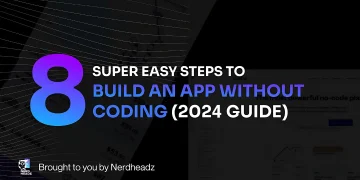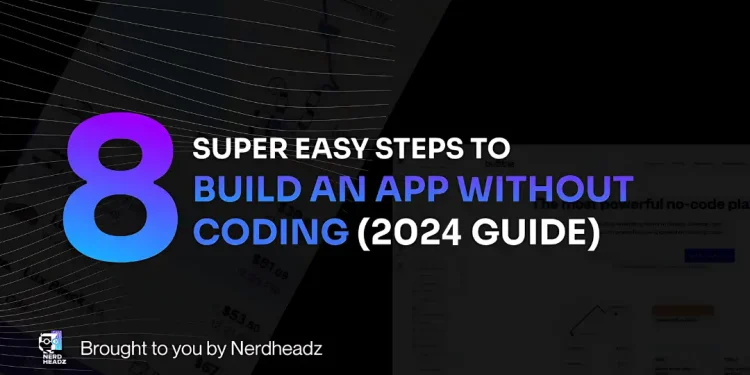Starting a business app used to mean hiring expensive developers, going through long development cycles, and understanding complex programming languages. But now, things have changed. Thanks to no-code platforms, building a business app has become easier and more affordable. Whether you’re a small business owner, entrepreneur, or part of a growing company, you can build a fully functional business app without writing a single line of code.
In this guide, I’ll walk you through the process of building a business app from scratch, share the benefits of no-code platforms, and help you decide which tools are right for your needs.
Why Build a Business App Without Coding?
Before we get into the process, let’s talk about why no-code platforms are a great option for building business apps. First, it’s all about speed. As a business owner, time is one of your most valuable resources. Traditional app development can take months, sometimes even years, to get from idea to launch. No-code platforms drastically reduce development time, allowing you to get your app to market faster.
Second, no-code platforms save money. Hiring developers, designers, and product managers can be expensive, especially for small businesses or startups. With a no-code platform, you can create an app at a fraction of the cost.
Finally, no-code platforms give you full control over your app. You don’t need to rely on a developer to make changes. If you need to tweak a feature or redesign a page, you can do it yourself with just a few clicks.
Step 1: Define Your App’s Purpose
The first step to building any app is having a clear idea of what it will do. What problem does your app solve? Who will use it, and how will it benefit them? Take some time to write down your app’s main goals and features. For example, if you’re building an app for your business, think about how it can streamline your operations, help your customers, or enhance internal workflows.
Start by answering these questions:
- What is the main function of your app?
- Who is your target audience (customers, employees, partners)?
- What features do you need to include (forms, payment gateways, user accounts)?
Once you have a clear vision for your app, you’ll be better prepared to choose the right no-code platform and start building.
Step 2: Choose the Right No-Code Platform
Choosing the right no-code platform depends on your business needs and the complexity of your app. Here are three popular no-code platforms that can help you build a business app without coding:
- Bubble: If you’re looking to build a complex web app with advanced functionality like user authentication, workflows, and database management, Bubble is one of the best options. You can design and launch your app directly from their platform. Bubble also offers a rich ecosystem of plugins to extend your app’s functionality. You can learn more and get started here: Bubble Review by Zeroqode.
- Webflow: If design is a priority and you want your app to look visually stunning, Webflow is a great option. It’s particularly suited for businesses that want to combine a beautiful website with interactive elements. However, if you need more advanced app functionalities, such as user authentication or complex workflows, you might prefer Bubble. For more insights, check out this Bubble vs Webflow Comparison Guide.
- Adalo: If you’re focused on building mobile apps for iOS or Android, Adalo offers an intuitive drag-and-drop interface. It’s perfect for startups or small businesses that need mobile apps for customer engagement, booking systems, or internal processes.
Each of these platforms offers different strengths, so consider your needs carefully before deciding which one to use.
Step 3: Plan Your App’s Features and Design
Now that you’ve chosen a no-code platform, it’s time to plan your app’s features and design. This is where you define the user interface (UI) and the user experience (UX). Think about how users will interact with your app. For example, if your app has forms, where will they go? How will users navigate from one screen to another?
You don’t need to be a designer to create a great-looking app. Most no-code platforms offer pre-built templates and design components that you can easily drag and drop. Make sure to focus on the key features that will add value to your users. Some common features for business apps include:
- User registration and login
- Payment processing
- Forms for data collection
- Task management or project tracking
Remember, it’s important to start simple. Build the essential features first, and you can always add more as your app grows.
Step 4: Build and Test Your App
Once you’ve outlined the design and features, it’s time to start building. Most no-code platforms offer an intuitive, visual interface that allows you to drag and drop elements onto the screen. For example, you can add a form to collect customer information, create buttons that trigger specific workflows, or integrate payment gateways to process transactions.
As you build, regularly test your app to make sure everything works smoothly. Testing is essential to ensure the user experience is intuitive and that all features function as expected. Make sure to:
- Check each workflow to ensure actions trigger correctly (e.g., a user submitting a form triggers an email notification).
- Test the app on different devices to ensure it’s responsive and looks good across mobile and desktop.
- Have a few people test the app and give feedback on any bugs or usability issues they find.
Step 5: Launch Your App
Once you’re satisfied with your app’s design and functionality, it’s time to launch. Most no-code platforms offer easy ways to publish your app, whether it’s a web app that’s hosted on their servers or a mobile app you submit to the App Store or Google Play.
Before launch, consider creating a plan for promoting your app. Share it with your existing customer base, promote it on social media, and use other marketing channels to get the word out. A successful launch can generate excitement and drive early adoption.
Step 6: Maintain and Improve Your App
The work doesn’t stop after launch. It’s important to monitor how your app is performing and gather feedback from users. Use that feedback to make improvements, fix bugs, and add new features. The great thing about no-code platforms is that they allow you to make changes quickly and easily. You don’t need to hire a developer every time you want to update your app.
Also, consider long-term scalability. As your business grows, your app will need to handle more users and possibly more complex functionality. Platforms like Bubble are designed to scale with your business, allowing you to continue building as your needs evolve. For additional tools and resources, you can explore Zeroqode’s no-code app development solutions.
Conclusion
Building a business app without coding has never been easier. No-code platforms offer the tools and flexibility you need to create a fully functional app in a fraction of the time and cost of traditional development.
By defining your app’s purpose, choosing the right platform, and following a structured process, you can launch an app that meets your business needs and helps you grow.
Whether you’re using Bubble for a complex web app or Webflow for a beautifully designed interface, no-code platforms give you the power to create without needing technical skills. Now it’s your turn to build the app that will take your business to the next level

























